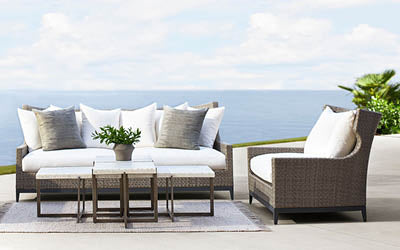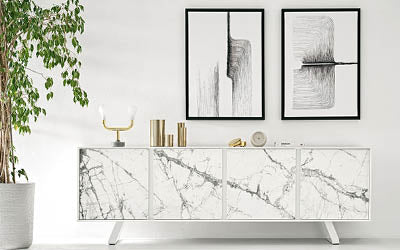Harmony Hall
A grand mansion offers proof that traditional and contemporary furnishings can play well together.

With its grand size and historical architectural detailing, this room might have looked like a museum if it had been furnished solely in traditional style. To make it a true living room for the homeowners, designers Mary Piselli and Karin Krinsky used mostly contemporary and transitional pieces.
Harmony in residential design comes from many elements, the most fundamental of which is pleasing proportions. Palladio recommended using the Harmonic Mean to calculate the ideal height of a room. According to the formula (which he derived from Plato’s Timeaus, if you must know), a room that is, say, 42 feet long and 21 feet wide would have a ceiling height of 28 feet. There are few large domestic spaces in the world, outside of Palladio’s Veneto, that meet this lofty standard, but the room you see here comes close.
What the room lacks in supposedly ideal height (imagine thinking this ceiling is too low!), it makes up for in other harmonious elements, such as a unified color palette, objects displayed in pairs and an abundance of natural light. “It’s the closest thing to a perfect room I’ve had the privilege to work on,” says Mary Piselli, an interior designer who uses Safavieh’s Manhasset, New York, design center as her go-to source for furniture, rugs and accessories. “Except for a few family heirlooms, every piece in the room comes from Safavieh.”
Most of the furniture features custom fabrics and finishes, if not custom sizing. “In a room this grand, you need some pieces made on a larger-than-average scale,” says Piselli. “The sleigh-like daybed is an example.”
While the architecture and moldings are rigorously historical, the furniture is

A corner of the living room displays a harmony of eclectic styles, with furniture from Safavieh complementing the homeowners’ artwork and grand piano. The Aubusson carpet was custom woven for the space.

Another view of the living room shows how symmetry can be relieved and enhanced by an occasional interruption. Pairs of chairs and the facing sofas are identical, but the two coffee tables are very different.

In the entrance hall, the architectural is so strong that very little furniture is needed. A center table and two baroque chairs fill the bill.
a mixture of historical reproductions, including chairs from the Althorp Collection, and contemporary and transitional pieces. Harmony by definition comes from variety, not sameness, and the modern touches in this room are critical to its success. “Without the newer pieces, the room could have looked like a museum,” says Karin Krinksy, a designer on staff at Safavieh, who worked with Piselli on the project. “Instead, it looks and feels like a home. The homeowners didn’t just want a showplace. They wanted a room they could really live in.”
Pictured above is another space in the house, the domed entrance hall, with the dining room glimpsed beyond. Because the hall is a high-traffic area, Piselli and Krinsky kept the furnishings sparse. Adequate drama comes from the hand-painted mural, the large compass rose inlaid in stone and, as Palladio would have it, the architecture itself.












